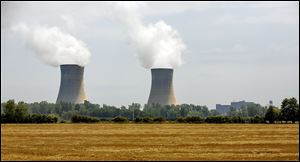
Fermi nuclear plant gets extension
S. Michigan site OK’d until 2045
12/17/2016NEWPORT, Mich. — DTE Energy’s Fermi 2 nuclear power plant in northern Monroe County is getting its operating license extended another 20 years, even though the plant has a couple of unresolved issues that regulators are working through.
The U.S. Nuclear Regulatory Commission made the long-anticipated announcement Friday.

The Enrico Fermi Nuclear Generating Station, or Fermi 2, is in Frenchtown Charter Township near Monroe, Mich. The NRC has extended its license 20 years to 2045.
With the extension, the plant is now licensed to operate through March 20, 2045.
“We’ve shown that we can operate well into the future and we look forward to future decades of providing safe, reliable electricity to our customers and our community in southeast Michigan,” said Paul Fessler, DTE senior vice president and chief nuclear officer at Fermi 2.
He said the license extension is “excellent news for Monroe County and Michigan.”
The plant has 800 full-time workers, the utility said.
The regulator’s decision ends a review process that began when DTE applied for the license extension on April 30, 2014, after the utility spent two years putting together the application.
It was challenged vigorously by several groups.
It also marks the 87th commercial nuclear power reactor which has been granted a 20-year extension by the NRC. None has been rejected by the agency, and three reactors that received extensions have since shut down.
Eight other applications remain pending before the NRC.
The other nuclear plant in the Toledo area, FirstEnergy Corp.’s Davis-Besse nuclear plant in Ottawa County, got its 20-year extension from the NRC last December after more than five years of review.
That plant came online eight years before Fermi 2. Davis-Besse is now licensed to continue operating through April 22, 2037.
Fermi 2 is the largest of 23 U.S. reactors with the same type of General Electric design as those at Japan’s Fukushima Daiichi complex, site of the world’s largest nuclear accident.
That disaster in Japan occurred on March 11, 2011, when a tsunami flooded the Fukushima complex and knocked out its power.
Activists continue their campaign to educate people near Fermi 2 about the potential benefits of taking potassium iodide if there’s ever a meltdown in this part of the world.
Approval came despite NRC online records showing several recent reports about Fermi 2’s secondary containment pressure boundary having issues that had to be reported to the government, per rules governing the plant. The latest occurred at 10:10 a.m. Thursday, involving a technical specification for secondary containment pressure boundary not being met for about 1 second.
Secondary containment pressure was returned and there “were no radiological releases associated with this event,” the notice said, which said such events or conditions “could have prevented the fulfillment of a safety function needed to control the release of radioactive material.”
Critics question how safe the plant’s safety systems are, based not so much on any one issue but the accumulation of issues over time. The systems in question involve the plant’s ability to capture radioactive gas in the event of an accident, and to have radioactive particles filtered out as the gas is sent up a 300-foot-high stack.
“There are frequent instances when the secondary containment at Fermi has not worked correctly when tested,” said Arnie Gundersen of Fairewinds Energy Education in Burlington, Vt. “These failures have happened often enough that I have no confidence it would work if there was a real accident.”
Guy Cerullo, DTE spokesman, said there “is absolutely no safety issue” and that the instances reported to the NRC are a result of sensitive instrumentation going off when there are high winds.
“These are very sensitive instruments and sometimes when we have high winds, they record readings indicating differential pressure in the buildings, for very short time periods — usually about one second,” he said. “This is an indication only. The actual conditions we are required to maintain are always maintained, but we are required by regulations to report the indications and that’s what we do.”
Modifications will make plant readings more accurate at detecting pressure in the buildings, he said.
Fermi 2 is about 30 miles north of downtown Toledo along the Lake Erie shoreline, roughly the same distance Davis-Besse is to the east.
NRC records show the plant began operating July 15, 1985. Its original license expires on March 20, 2025.
The NRC said its operating board agreed Wednesday to let the agency’s director of the Office of Nuclear Reactor Regulation issue the renewed license despite a pending motion before the NRC’s Atomic Safety and Licensing Board to reopen the adjudicatory hearing.
The request for that hearing, raised by Citizens’ Resistance at Fermi 2, or CRAFT, is over the potassium iodide issue. The group wants distribution within the required 10-mile evacuation zone, based partly because of lessons from Japan’s Fukushima disaster.
Mike Keegan of the anti-nuclear group Don’t Waste Michigan called the relicensing process “a charade,” while attorney Terry Lodge, who represents area activist groups, said it is an “exasperating” process that leaves challengers feeling helpless.
Contact Tom Henry at: thenry@theblade.com, 419-724-6079, or via Twitter @ecowriterohio.